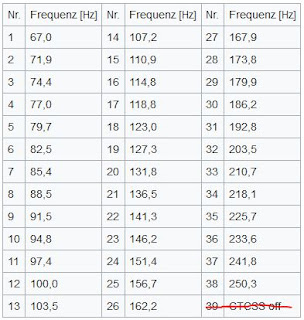The default data format is: 8 data bits, 1 stop bit, no parity and 9600 kbps data rate.
All commands in ASCII codes start with “AT” and end with “<CR><LF>”.
Module response: +DMOCONNECT: 0 <CR><LF>
(+DMOCONNECT: 1 means wrong syntax)
Volume: + DMOSETVOLUME: X<CR><LF> (X= 1~8)
To configure a group of module parameters you can use this command:
AT+DMOSETGROUP=GBW,TFV, RFV,Tx_CTCSS,SQ,Rx_CTCSS<CR><LF>
e.g.: AT+DMOSETGROUP=0,145.0750,145.6750,0018,2,0000<CR><LF>
GBW: Channels space. 0=12.5 kHz; 1=25 kHz
TFV: Transmit frequency. Range: 134.0000~174.0000 MHz
RFV: Receive frequency. Range: 134.0000~174.0000 MHz.
The frequencyes should be multiples of 12.5 kHz or 25 kHz.
Tx_CTCSS: CTCSS value in transmit. (number of code e.g.: 0012 = 100 Hz)
Rx_CTCSS: CTCSS value in receive. (number of code e.g.: 0017 = 118,8 Hz)
SQ: Squelch level (0~8). 0=monitor mode which can’t be used in scanning mode.
List of CTCSS - Numbers:
By receiving a signal the status of the squelch pin changes from high to low.
Consult the product datasheed for more informations.


Keine Kommentare:
Kommentar veröffentlichen
Hinweis: Nur ein Mitglied dieses Blogs kann Kommentare posten.